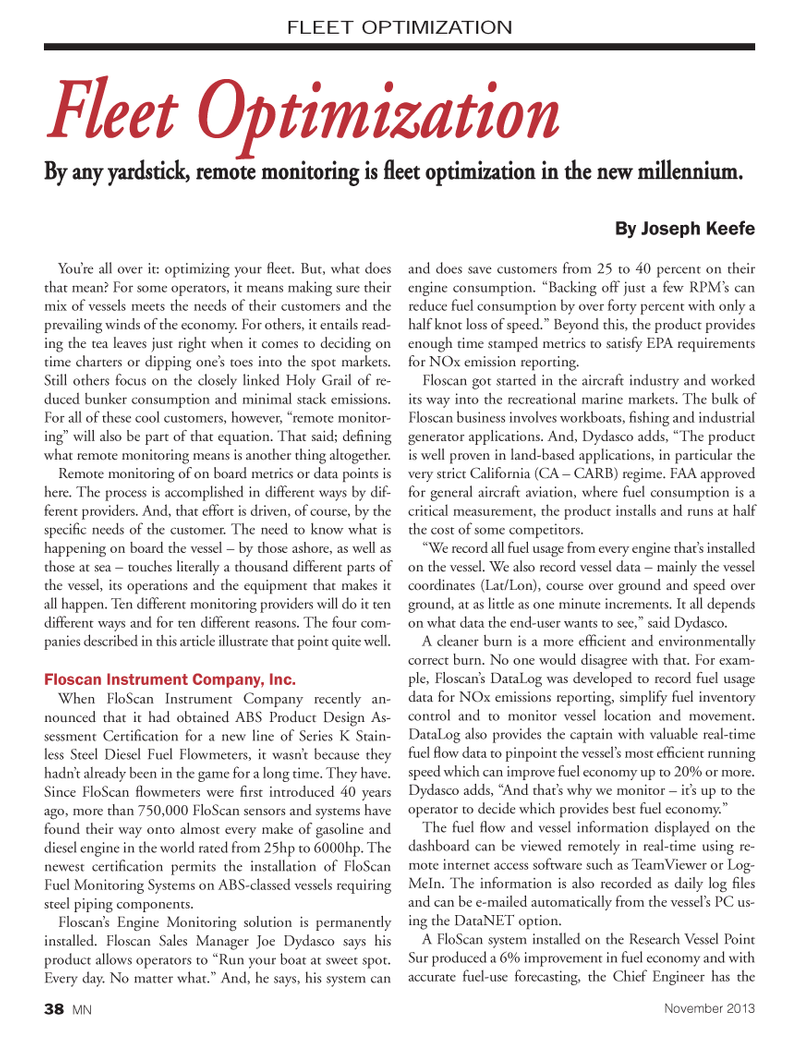
Page 38: of Marine News Magazine (November 2013)
Fleet Optimization Roundtable
Read this page in Pdf, Flash or Html5 edition of November 2013 Marine News Magazine
You?re all over it: optimizing your eet. But, what does that mean? For some operators, it means making sure their mix of vessels meets the needs of their customers and the prevailing winds of the economy. For others, it entails read- ing the tea leaves just right when it comes to deciding on time charters or dipping one?s toes into the spot markets. Still others focus on the closely linked Holy Grail of re- duced bunker consumption and minimal stack emissions. For all of these cool customers, however, ?remote monitor- ing? will also be part of that equation. That said; de ning what remote monitoring means is another thing altogether. Remote monitoring of on board metrics or data points is here. The process is accomplished in different ways by dif- ferent providers. And, that effort is driven, of course, by the speci c needs of the customer. The need to know what is happening on board the vessel ? by those ashore, as well as those at sea ? touches literally a thousand different parts of the vessel, its operations and the equipment that makes it all happen. Ten different monitoring providers will do it ten different ways and for ten different reasons. The four com- panies described in this article illustrate that point quite well. Floscan Instrument Company, Inc. When FloScan Instrument Company recently an- nounced that it had obtained ABS Product Design As- sessment Certi cation for a new line of Series K Stain- less Steel Diesel Fuel Flowmeters, it wasn?t because they hadn?t already been in the game for a long time. They have. Since FloScan owmeters were rst introduced 40 years ago, more than 750,000 FloScan sensors and systems have found their way onto almost every make of gasoline and diesel engine in the world rated from 25hp to 6000hp. The newest certi cation permits the installation of FloScan Fuel Monitoring Systems on ABS-classed vessels requiring steel piping components. Floscan?s Engine Monitoring solution is permanently installed. Floscan Sales Manager Joe Dydasco says his product allows operators to ?Run your boat at sweet spot. Every day. No matter what.? And, he says, his system can and does save customers from 25 to 40 percent on their engine consumption. ?Backing off just a few RPM?s can reduce fuel consumption by over forty percent with only a half knot loss of speed.? Beyond this, the product provides enough time stamped metrics to satisfy EPA requirements for NOx emission reporting. Floscan got started in the aircraft industry and worked its way into the recreational marine markets. The bulk of Floscan business involves workboats, shing and industrial generator applications. And, Dydasco adds, ?The product is well proven in land-based applications, in particular the very strict California (CA ? CARB) regime. FAA approved for general aircraft aviation, where fuel consumption is a critical measurement, the product installs and runs at half the cost of some competitors.?We record all fuel usage from every engine that?s installed on the vessel. We also record vessel data ? mainly the vessel coordinates (Lat/Lon), course over ground and speed over ground, at as little as one minute increments. It all depends on what data the end-user wants to see,? said Dydasco. A cleaner burn is a more ef cient and environmentally correct burn. No one would disagree with that. For exam- ple, Floscan?s DataLog was developed to record fuel usage data for NOx emissions reporting, simplify fuel inventory control and to monitor vessel location and movement. DataLog also provides the captain with valuable real-time fuel ow data to pinpoint the vessel?s most ef cient running speed which can improve fuel economy up to 20% or more. Dydasco adds, ?And that?s why we monitor ? it?s up to the operator to decide which provides best fuel economy.? The fuel ow and vessel information displayed on the dashboard can be viewed remotely in real-time using re- mote internet access software such as TeamViewer or Log- MeIn. The information is also recorded as daily log les and can be e-mailed automatically from the vessel?s PC us- ing the DataNET option. A FloScan system installed on the Research Vessel Point Sur produced a 6% improvement in fuel economy and with accurate fuel-use forecasting, the Chief Engineer has the Fleet Optimization Fleet Optimization By any yardstick, remote monitoring is ß eet optimization in the new millennium. By any yardstick, remote monitoring is ß eet optimization in the new millennium. By Joseph Keefe FLEET OPTIMIZATION November 201338 MNMN November2013 Layout 32-49.indd 38MN November2013 Layout 32-49.indd 3810/28/2013 3:18:58 PM10/28/2013 3:18:58 PM

 37
37

 39
39
